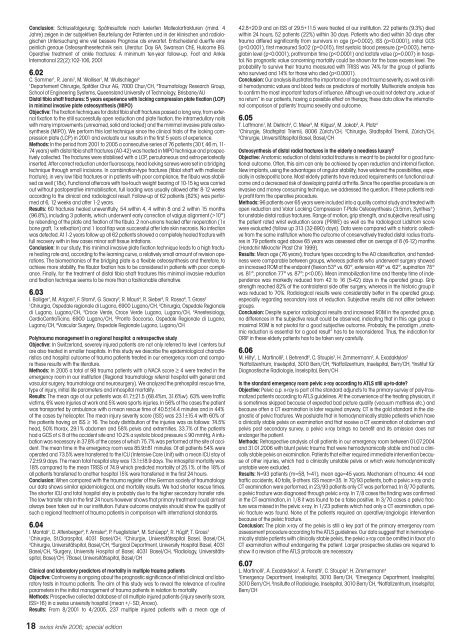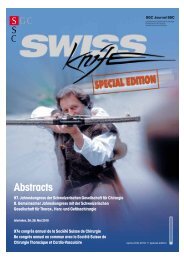Abstracts 4. Gemeinsamer Jahreskongress der ... - SWISS KNIFE
Abstracts 4. Gemeinsamer Jahreskongress der ... - SWISS KNIFE
Abstracts 4. Gemeinsamer Jahreskongress der ... - SWISS KNIFE
You also want an ePaper? Increase the reach of your titles
YUMPU automatically turns print PDFs into web optimized ePapers that Google loves.
swissknife spezial 06 12.06.2006 13:39 Uhr Seite 18<br />
Conclusion: Schlussfolgerung: Spätresultate nach luxierten Malleolarfrakturen (mind. 4<br />
Jahre) zeigen in <strong>der</strong> subjektiven Beurteilung <strong>der</strong> Patienten und in <strong>der</strong> klinischen und radiologischen<br />
Untersuchung eine viel bessere Prognose als erwartet. Entscheidend duerfte eine<br />
peinlich genaue Osteosynthesetechnik sein. Literatur: Day GA, Swanson ChE, Hulcome BG.<br />
Operative treatment of ankle fractures: A minimum ten-year follow-up. Foot and Ankle<br />
International 22(2):102-106, 2001<br />
6.02<br />
C. Sommer1 , R. Jenni1 , M. Walliser1 , M. Wullschleger2 1 2 Departement Chirurgie, Spitäler Chur AG, 7000 Chur/CH, Traumatology Research Group,<br />
School of Engineering Systems, Queensland University of Technology, Brisbane/AU<br />
Distal tibia shaft fractures: 5 years experience with locking compression plate fixation (LCP)<br />
in minimal invasive plate osteosynthesis (MIPO)<br />
Objective: The fixation techniques for distal tibia shaft fractures passed a long way, from external<br />
fixation to the still successfully open reduction and plate fixation, the intramedullary nails<br />
with many improvements (unreamed, solid and locked) and the minimal invasive plate osteosynthesis<br />
(MIPO). We perform this last technique since the clinical trials of the locking compression<br />
plate (LCP) in 2001 and evaluate our results in the first 5 years of experience.<br />
Methods: In the period from 2001 to 2005 a consecutive series of 76 patients (30 f, 46 m, 11-<br />
74 years) with distal tibia shaft fractures (AO-42) was treated in MIPO technique and prospectively<br />
collected. The fractures were stabilised with a LCP, percutaneous and extra-periosteally<br />
inserted. After correct reduction un<strong>der</strong> fluoroscopy, head locking screws were set in a bridging<br />
technique through small incisions. In combination-type fractures (tibial shaft with malleolar<br />
fracture), in very low tibia fractures or in patients with poor compliance, the fibula was stabilised<br />
as well (18x). Functional aftercare with toe-touch weight bearing of 10-15 kg was carried<br />
out without postoperative immobilisation, full loading was usually allowed after 8-12 weeks<br />
according to the clinical and radiological result. Follow-up of 62 patients (82%) was performed<br />
at 6, 12 weeks and after 1-2 years.<br />
Results: 60 fractures healed uneventfully, 54 within 4, 4 within 8 and 2 within 15 months<br />
(96.8%), including 3 patients, which un<strong>der</strong>went early correction of valgus alignment (>10°)<br />
by rebending of the plate and fixation of the fibula. 2 non-unions healed after reoperation (1x<br />
bone graft, 1x refixation) and 1 local flap was successful after late skin necrosis. No infection<br />
was detected. At 1-2 years follow up all 62 patients showed a completely healed fracture with<br />
full recovery with in few cases minor soft tissue irritations.<br />
Conclusion: In our study, this minimal invasive plate fixation technique leads to a high fracture<br />
healing rate and, according to the learning curve, a relatively small amount of revision operations.<br />
The biomechanics of the bridging plate is a flexible osteosynthesis and therefore, to<br />
achieve more stability, the fibular fixation has to be consi<strong>der</strong>ed in patients with poor compliance.<br />
Finally, for the treatment of distal tibia shaft fractures this minimal invasive reduction<br />
and fixation technique seems to be more than a fashionable alternative.<br />
6.03<br />
I. Bolliger1 , M. Arigoni2 , F. Storni2 , G. Savary3 , R. Mauri4 , R. Sieber5 , R. Rosso6 , T. Gross2 1 2 Chirurgia, Ospedale regionale di Lugano, 6900 Lugano/CH, Chirurgia, Ospedale Regionale<br />
di Lugano, Lugano/CH, 3Croce Verde, Croce Verde Lugano, Lugano/CH, 4Anestesiology, CerdioCentroTicino, 6900 Lugano/CH, 5Pronto Soccorso, Ospedale Regionale di Lugano,<br />
Lugano/CH, 6Vascular Surgery, Ospedale Regionale Lugano, Lugano/CH<br />
Polytrauma management in a regional hospital: a retrospective study<br />
Objective: In Switzerland, severely injured patients are not only referred to level I centers but<br />
are also treated in smaller hospitals. In this study we describe the epidemiological characteristics<br />
and hospital outcome of trauma patients treated in our emergency room and compare<br />
these results with the literature.<br />
Methods: In 2005 a total of 98 trauma patients with a NACA score ≥ 4 were treated in the<br />
emergency room in our institution (Regional traumatology referral hospital with general and<br />
vascular surgery, traumatology and neurosurgery). We analyzed the prehospital rescue time,<br />
type of injury, initial life parameters and inhospital mortality.<br />
Results: The mean age of our patients was 41.7±21.5 (68.4%m, 31.6%w). 63% were traffic<br />
victims, 6% were injuries at work and 5% were sports injuries. In 56% of the cases the patient<br />
was transported by ambulance with a mean rescue time of 40.5±1<strong>4.</strong>4 minutes and in 44%<br />
of the cases by helicopter. The mean injury severity score (ISS) was 23.1±15.4 with 60% of<br />
the patients having an ISS ≥ 16. The body distribution of the injuries was as follows: 7<strong>4.</strong>5%<br />
head, 50% thorax, 29.1% abdomen and 58% pelvis and extremities. 33.7% of the patients<br />
had a GCS of ≤ 8 at the accident site and 10.2% a systolic blood pressure ≤ 90 mmHg. A intubation<br />
was necessary in 37.8% of the cases of which 75.7% was performed at the site of accident.<br />
The mean time in the emergency room was 85.9±81 minutes. Of all patients 54% were<br />
operated and 73.5% were transferred to the ICU (Intensive Care Unit) with a mean ICU stay of<br />
7.2±9.9 days. The mean total hospital stay was 13.1±18.9 days. The inhospital mortality was<br />
18% compared to the mean TRISS of 7<strong>4.</strong>9 which predicted mortality of 25.1%. of the 18% of<br />
all patients transferred to another hospital 15% were transferred in the first 24 hours.<br />
Conclusion: When compared with the trauma register of the German society of traumatology<br />
our data shows similar epidemiological, and mortality results. We had shorter rescue times.<br />
The shorter ICU and total hospital stay is probably due to the higher secondary transfer rate.<br />
The low transfer rate in the first 24 hours however shows that primary treatment could almost<br />
always been taken out in our institution. Future outcome analysis should show the quality of<br />
such a regional treatment of trauma patients in comparison with international standards.<br />
6.04<br />
I. Montali 1 , C. Attenberger 2 , F. Amsler 3 , P. Fueglistaler 4 , M. Schüepp 5 , R. Hügli 6 , T. Gross 7<br />
1 Chirurgie, St.Claraspital, 4031 Basel/CH, 2 Chirurgie, Universitätsspital Basel, Basel/CH,<br />
3 Chirurgie, Universitätspital, Basel/CH, 4 Surgical Department, University Hospital Basel, 4031<br />
Basel/CH, 5 Surgery, University Hospital of Basel, 4031 Basel/CH, 6 Radiology, Universitätsspital,<br />
Basel/CH, 7Basel, Universitätsspital, Basel/CH<br />
Clinical and laboratory predictors of mortality in multiple trauma patients<br />
Objective: Controversy is ongoing about the prognostic significance of initial clinical and laboratory<br />
tests in trauma patients. The aim of this study was to reveal the relevance of routine<br />
parameters in the initial management of trauma patients in relation to mortality.<br />
Methods: Prospective collected database of all multiple injured patients (injury severity score,<br />
ISS>16) in a swiss university hospital (mean +/- SD; Anova).<br />
Results: From 8/2001 to 4/2005, 237 multiple injured patients with a mean age of<br />
18 swiss knife 2006; special edition<br />
42.8+20.9 and an ISS of 29.5+11.5 were treated at our institution. 22 patients (9.3%) died<br />
within 24 hours, 52 patients (22%) within 30 days. Patients who died within 30 days after<br />
trauma differed significantly from survivors in age (p=0.002), ISS (p
















